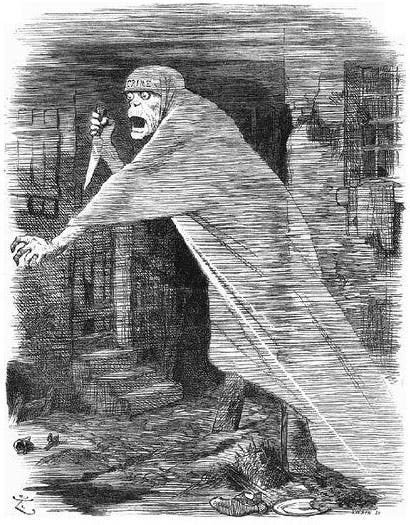
“There floats a phantom on the slum’s foul air,
Shaping, to eyes which have the gift of seeing,
Into the Spectre of that loathly lair.
Face it–for vain is fleeing!
Red-handed, ruthless, furtive, unerect,
‘Tis murderous Crime–the Nemesis of Neglect! “
Published September 29, 1888, London.
The identity of one of the most notorious and gruesome serial killers in modern history may have been exposed by a new DNA study. According to genetic tests, samples taken from the stained silk shawl of one of Jack the Ripper’s victims match the genetic profile of Aaron Kosminski, a 23-year-old Polish barber and a prime police suspect at the time.
When mystery meets science
Jack the Ripper murdered at least five women, all prostitutes, in or near the Whitechapel district of London’s East End, between August and November 1888. All but one of Jack the Ripper’s victims were killed while soliciting customers on the street. In each instance, the victim’s throat was cut, and the body was usually mutilated in such a manner as to suggest that the murderer was knowledgeable of human anatomy.
The murders abruptly ceased in November 1888, but the mystery only deepened and grew. Nearly 140 years later, the case still remains unsolved and Jack the Ripper has become arguably the most infamous and most mythologized serial killer.

However, modern tools might finally bring the case to rest. In a new study, Jari Louhelainen, a biochemist at Liverpool John Moores University in the United Kingdom, and colleagues have investigated the silk shawl that belonged to Catherine Eddowes, the killer’s fourth victim. The shawl is stained with blood and semen, the latter believed to have come from the woman’s killer.
Writing in the Journal of Forensic Science, Louhelainen and David Miller, a reproduction expert at the University of Leeds, describe extracting and amplifying the DNA from the shawl. Mitochondrial DNA –– the DNA inherited only from the mother’s side and also the hardiest kind of DNA — retrieved from the shawl was compared to samples taken from the living descendants of Eddowes and Kosminski.
Aaron Kosminski was a Polish Jew who was committed to an insane asylum for the rest of his days not long after the murders abruptly stopped. According to the researchers, the mtDNA of Kosminski’s relatives matches that found in samples retrieved from the shawl. The analysis also suggests that the killer had brown eyes and brown hair, which matches Kosminski’s description — but also that of thousands of other Londoners at the time. The authors claim that no modern contamination was found on the shawl.
“We describe for the first time systematic, molecular level analysis of the only surviving physical evidence linked to the Jack the Ripper murders,” the authors wrote in their study. “Finding both matching profiles in the same piece of evidence enhances the statistical probability of its overall identification and reinforces the claim that the shawl is authentic.”
“All the data collected support the hypothesis that the shawl contains biological material from Catherine Eddowes and that the mtDNA sequences obtained from semen stains match the sequences of one of the main police suspects, Aaron Kosminski,” the researchers conclude.
The case is not closed, however. For one, the origin of the shawl is contentious. It used to be the possession of the great-great nephew of an acting sergeant in the London police who was among those investigating the Eddowes crime scene. Author Russell Edwards bought the shawl in 2007 and gave it to Louhelainen, whose preliminary genetic results were used to single out Kosminski in Edward’s 2014 book called Naming Jack the Ripper.
What’s more, mtDNA cannot reliably identify a person the way nuclear DNA — which inherited from both parents — is able to. Based on mtDNA alone, the only certainty lies in excluding suspects.
Previously, US crime author Patricia Cornwell financed her own DNA investigation. DNA from samples taken from letters supposedly sent by Jack the Ripper to the police suggest that the killer was painter Walter Sickert. These findings are also controversial since many believe the letters were fake, part of elaborate hoaxes from the time when Jack the Ripper scandalized London society. Another genetic investigation suggested that Jack the Ripper was actually a woman.


